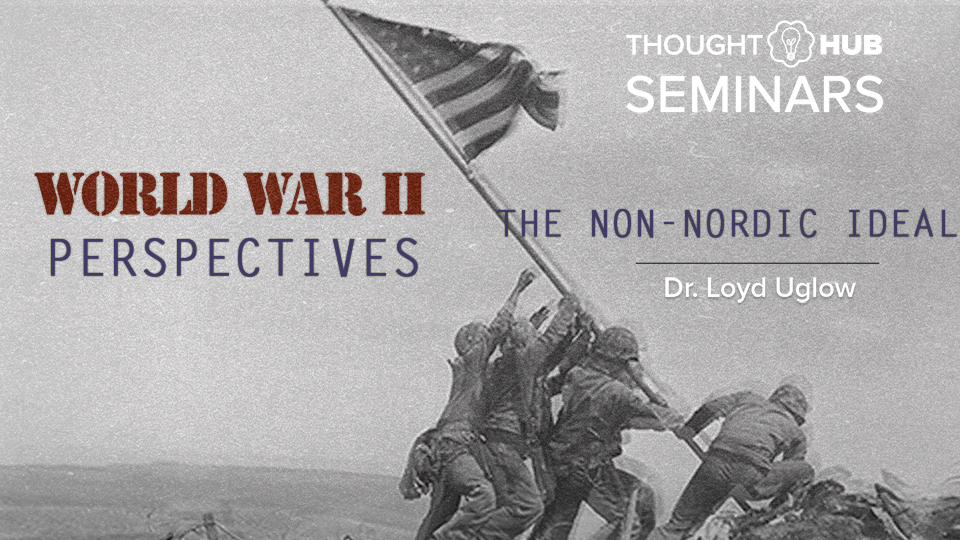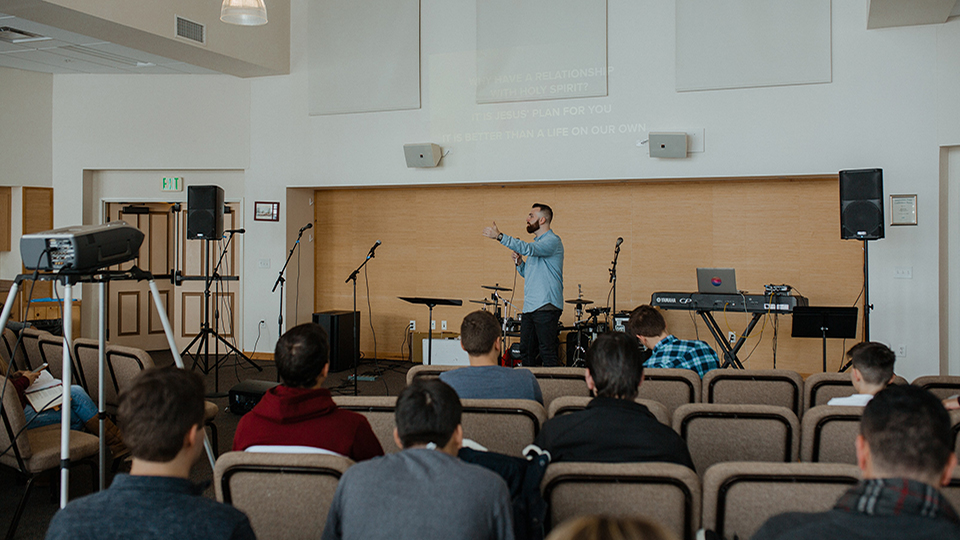
In 1942, the German military was actually stretched so thin across all of Europe that they had no option but to open the doors to non-Germans. But why would non-Germans agree to fight for the Nazi Armies especially when Germans regarded them as an inferior race? How did the Nazis convince men from countries that they had conquered to fight in the German military? In this Thought Hub vlog on WWII Perspectives, Dr. Loyd Uglow discusses the reasoning and tactics behind this unusual turn-of-events in WWII history.
TRANSCRIPT
-[MUSIC PLAYING] We’re going to talk to you today about what I term the non-Nordic ideal– non-Germans in Nazi armies. During the massive D-Day invasion in 1944, American troops captured a large number of German soldiers in the beach defenses, as you might expect. However, the Americans noticed something special about a handful of the German prisoners taken on Utah Beach. They weren’t really Germans at all. But before I tell you who they were, I think we need to lay some ground work on the entire German military. Adolf Hitler and the Nazi party that took over Germany in 1933 placed great importance on racial matters. As most people know, they promoted German racial superiority as part of the ideal Nordic sub-race. Different races, including the other sub-races of Europeans were inferior physically, mentally, and morally with the Jewish people being at or near the bottom of the list on all three counts. The Nordic individual, as you can see a good representation of them here, was tall, with light colored eyes, preferably blue but gray or green would do, a long head, and a strong nose. According to certain racial theories of the late 19th and early 20th centuries, this Nordic segment of the European race was proud, honest, individualistic, and innovative. Sometimes the Nazis also refer to the Nordic sub-race as Arians. You may have heard this term before in association with the Nazis. Although really, Arians as a group actually had little connection with Germans in history. The Nazis expected their females to be every bit as hardy and as ardent in their Nazi political beliefs as the males. Notice the Nazi buddy barrel up there, the girl on the right. She’s apparently connecting– or collecting money for the cause. German families were encouraged to have a lot of little Nazis. Beyond that, to promote Aryan racial purity the government developed a program called Lebensborn that rewarded unmarried German women who had the proper racial characteristics for having children with German officers. The babies would then be raised in Nazi families and subsidized by the government. Other racially pure babies that would have been aborted by their mothers were taken and raised through the Lebensborn program. Some qualifying babies in occupied countries like Poland– that is, countries that the Germans had conquered– they were even kidnapped by the Nazis and placed in Lebensborn homes. So how did Hitler himself stack up as a Nordic type? I’d say he might have been given a C on a normal grade scale of A to F. He had startling blue eyes all right and he was certainly proud and individualistic and innovative, but he was barely medium height and his hair was brown– not at all blond. Now let’s look at a few of the Nordic specimens the Nazis pubs publicized to show the kind of man they were looking for. This young man was on a recruiting poster for the German army, and a major German newspaper described him as being, quote, the ideal German soldier. This SS major had the facial features and coloring that the Nazis idolized. Now from those two guys, the surprising thing is that one of them is actually a Jew. The man on the right, his name is Private Werner Goldberg. He was pictured on recruiting posters until they discovered what his family background was. Then he was kicked out of the Army, and the posters were taken down. Sometimes, even when the truth was known, racial inferiors were tolerated by the Nazis. Field Marshal Milch, pictured here, was half Jewish, but he continued to serve in the German military throughout the war. A considerable number of German officers, some of high rank, were part Jewish. For one reason or another, great ability or sometimes just past ties with Hitler or other Nazi leaders, these men were allowed to stay in spite of the Jewish family background. The German military was stretched so thin across all of Europe that by 1942, they had to open the doors to non-Germans. First, they recruited men from nations that were racially like the Germans, especially other Nordic countries, those in the northern part of Europe. The Norwegians, for example. They weren’t Germans, but they would make excellent ski troops. Now how did the Nazis convince men from countries that they had conquered to fight in the German military? One answer can be seen in the recruiting poster in the middle, and also the one on the left. Can you make out the term Bolshevism? In other words, communism. Hatred for communism was so strong among many of the people in Europe that they preferred even the Nazis to Joseph Stalin’s Soviet Union. It wasn’t unheard of among other nations to enlist foreign troops in their armies. For example, as you can see here, the Free French military forces under General Charles de Gaulle had tens of thousands of Africans in their units. The British army had troops from a number of other countries all around the globe, countries that were part of the British empire. These soldiers are Gurkhas, that you see here, from the Himalaya nation of Nepal, but they are part of the British army. And while they weren’t exactly foreign troops, the United States used many Japanese-Americans, who were just a tiny minority group in the United States. Most of these men were concentrated in what’s called the 442nd Regimental Combat Team. Now this unit did not fight against the Japanese in the war. They were used in Europe against the Germans. In fact, this unit, the 442nd, received more decorations for bravery than virtually any other American combat unit in the war. No one could match the Germans though in using troops of other nationalities. The Waffen-SS was a special elite branch of the German armed forces, separate from the regular army, that accepted volunteers from a great many nationalities. The regular German army conscripted foreigners as well. As time went on, Germany needed more and more men, and their racial standards were lowered. So men from southern Europe and Eastern Europe and even eventually Africa and Asia found their way into Hitler’s military. And I want to read what Otto Skorzeny, a colonel in the SS said here as he listed the different nationalities that were part of the SS forces in the war. “Albanians, Bosnians, Britons, Bulgarians, Cossacks, Croats, Danes, Dutch, Estonians, Finns, Flemings, French, Georgians, Greeks, Hungarians, Italians, Latvians, Lithuanians, Norwegians, Romanians, Russians, Serbs, Slovakians, Swedes, Swiss, Ukrainian, and Walloons, as well Armenians, Byelorussians, Hindus, Tartars, Turkomen, and Uzbeks served under their own flag in the Waffen-SS. Almost all of these peoples were represented in my unit.” So many Soviet soldiers, that is Russian soldiers, hated their own dictator, Stalin, and the communist government of the Soviet Union that hundreds of thousands of Soviet troops that were captured by the Germans volunteered to fight alongside them against the Soviet Union. Captured Russian general Vlasov, and he is pictured here, was placed in command of many of these troops in the war against the Soviet Union. When the Allied forces invaded Normandy in German occupied France on D-Day June 6, 1944, they faced German troops, of course, but also they faced a few Indian soldiers in the German army, pictured here with Field Marshal Erwin Rommel the German commander in France at the time. In addition, they had to fight Polish troops in the German army, Russian troops, and as you can see here, various others, including even some from the Far East. The next slide was to have the numbers of troops from foreign countries that served in the German military. About 2 million of them from other nations in Eastern Europe served in the German military during the war and tens of thousands, sometimes hundreds of thousands, from areas really near what we prayed for today in the Caucasus Mountain region, we prayed for Armenia. Probably 100,000 Armenians served in the German army, thousands and thousands of other Europeans, quite a few from Central Asia. It was a large number, and it helped the Germans very much. Now I suppose I’d better explain why those German prisoners or who those German prisoners were that I mentioned to you at the very beginning of this presentation, the ones that were captured on D-Day but weren’t Germans at all. I think perhaps the strangest odyssey of any troops in the war involved this group of people, a handful of Korean soldiers drafted at first into the Japanese army in 1938, who then were captured by the Soviet Army in border fighting with Japan in 1939. And the Soviets drafted those guys into their own army and sent them to fight the invading Germans in 1941. Those Koreans were captured by the Germans and eventually forced into the German army and eventually sent to France, where they ended up fighting against the Americans on D-Day and being captured yet again. Sometimes it was just hard to tell who was on the other side of the battlefield from you. Thank you. [MUSIC PLAYING]
Want more ThoughtHub content?
Join the 3000+ people who receive our newsletter.
*ThoughtHub is provided by SAGU, a private Christian university offering more than 60 Christ-centered academic programs – associates, bachelor’s and master’s and doctorate degrees in liberal arts and bible and church ministries.



